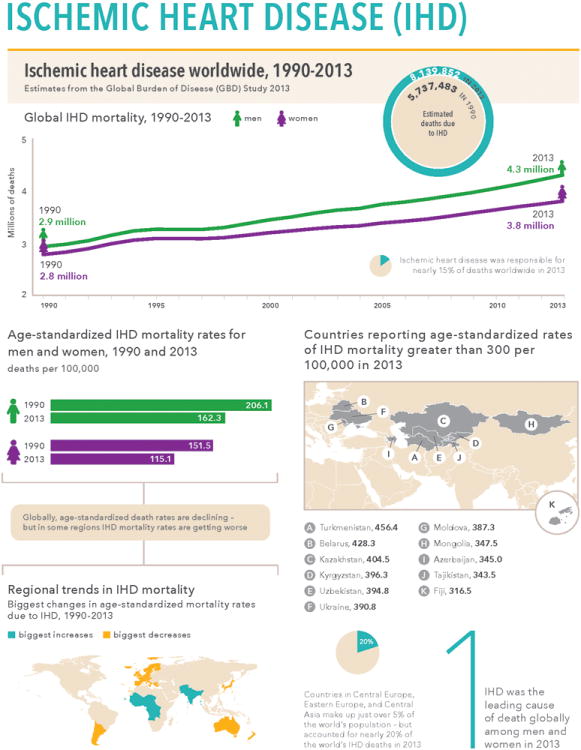Ischemic heart disease (IHD) was responsible for 8.1 million deaths in 2013 (95% uncertainty interval 7.3 million, 8.8 million), the most recent year estimated, which was 14.8% of deaths worldwide (95% uncertainty interval 13.4%, 15.8%). IHD was the leading cause of death globally among men and women in both 1990 and 2013. In 2013, it was responsible for nearly half of all deaths from cardiovascular disease, causing as many deaths as COPD, diabetes, cirrhosis, lung cancer, and liver cancer combined. There was an increase of 42% (95% uncertainty interval 36%, 48%) in the number of IHD deaths since 1990. The number of men dying from IHD was consistently higher than the number of women during this time period, and there was a larger relative increase in IHD deaths among men than among. However, IHD is responsible for a slightly higher percentage of deaths among women than among men (15.3% versus 14.4%) because of significantly more IHD deaths among women over age 80.
The countries reporting the highest age-standardized rates of IHD mortality are primarily in Central Asia and Eastern Europe, but countries in South Asia have seen substantial increases in age-standardized IHD mortality rates during the last two decades. In marked contrast, high-income countries have reported sharp decreases in age-standardized mortality rates. High-income regions saw mortality rates decline by as much as 50% or more between 1990 and 2013 and now account for some of the lowest IHD mortality rates in the world. Age-standardized death rates are also lower in most of sub-Saharan Africa; however, much of this region saw one of the highest relative increases in age-standardized mortality between 1990 and 2013. At the country level, the upper and lower extremes of IHD mortality rates vary by an order of magnitude: in Belarus, age-standardized mortality rates among men exceeded 600 per 100,000 in 2013; on the other hand, females in Japan reported mortality rates in 2013 of 31 per 100,000.
Method
The Global Burden of Disease Study 2013 produced consistent measures of death by age and sex for 188 countries for the years 1990 to 2013 for 240 causes of death. Detailed methods and results have been reported.1 Briefly, all available data on mortality were collected, including data from vital registration and verbal autopsy. Nonspecific conditions reported as underlying causes of death were redistributed using statistical methods or expert opinion. Versions of death coding were mapped to a uniform system. Ensemble modeling was used to estimate cause-specific mortality using death data and country-level covariates. Out-of-sample validity testing was performed for each cause-specific model, and uncertainty was estimated by taking 1,000 draws from the posterior distribution of the ensemble model, with point estimates taken as the median value. Cause-specific death was adjusted to fit the envelope of global all-cause mortality. In this visualization we restricted country-level estimates to those countries which produce vital registration or verbal autopsy data. The figure was created with Adobe Illustrator.
Figure.

Ischemic heart disease worldwide, 1990–2013, from the Global Burden of Disease Study 2013. Source: Institute for Health Metrics and Evaluation
Acknowledgments
Sources of Funding: The Bill and Melinda Gates Foundation.
Footnotes
Disclosures: None.
Contributor Information
Dawn Shepard, Institute for Health Metrics and Evaluation, University of Washington.
Amelia VanderZanden, Institute for Health Metrics and Evaluation, University of Washington.
Andrew Moran, Division of General Medicine, Columbia University Medical Center.
Mohsen Naghavi, Institute for Health Metrics and Evaluation, University of Washington.
Christopher Murray, Institute for Health Metrics and Evaluation, University of Washington.
Gregory Roth, Institute for Health Metrics and Evaluation, University of Washington.
References
- 1.GBD 2013 Mortality and Causes of Death Collaborators. Global, regional, and national age–sex specific all-cause and cause-specific mortality for 240 causes of death, 1990–2013: a systematic analysis for the Global Burden of Disease Study 2013. The Lancet. 2015;385:117–171. doi: 10.1016/S0140-6736(14)61682-2. [DOI] [PMC free article] [PubMed] [Google Scholar]


